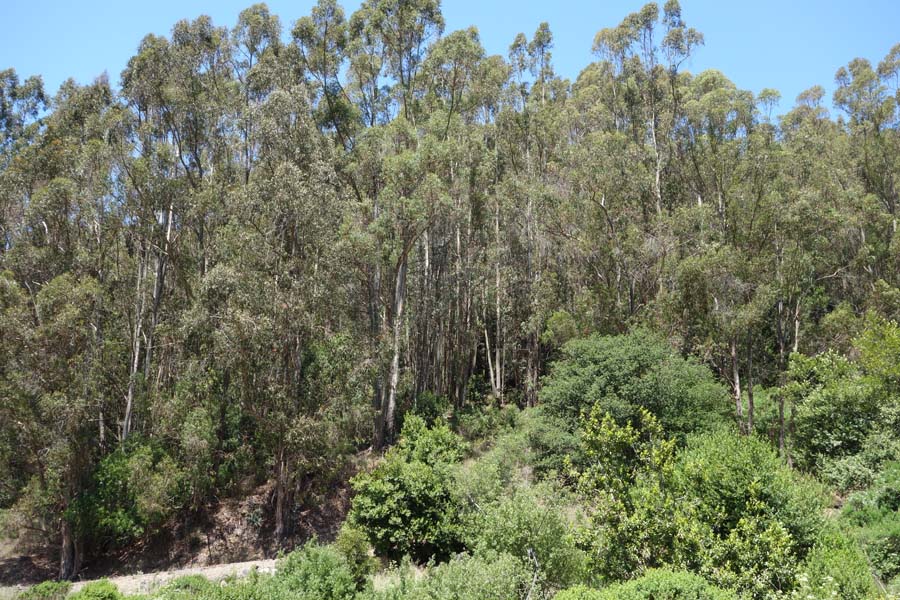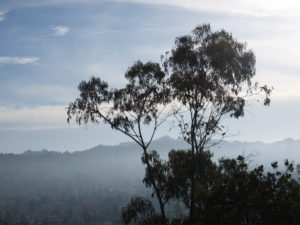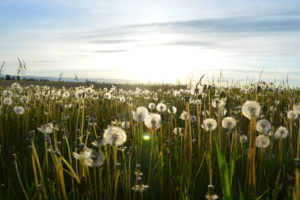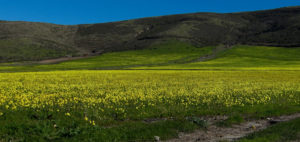Our article about the tree removal debate in the East Bay inspired a lot of discussion, including questions about the value of eucalyptus as raptor habitat and the risk to local amphibians of extensive herbicide use in wild lands. The proposal is up for public comment through Monday and there’s a meeting sponsored by critics of the plan this evening. (Here’s more info on those.)
There’s no way to cover either the impacts on raptors or amphibians exhaustively, except perhaps in the context of a scientific monograph of some kind (which we don’t write here at Bay Nature!). But we did go in search of some answers from folks who know more than we do. First, I went back and reread our own article, Ubiquitous Eucalyptus, from 2006. That reminded me of Dan Suddjian’s 2004 survey of bird use of eucalyptus around Monterey. Suddjian notes that eucs aren’t much use for cavity nesters, but he did find 59 species of birds nesting in eucalyptus, and 90 species that use the trees regularly for perching, roosting, and feeding. That’s a lot of birds. On the other hand, he found that bird species that favor oak woodlands and riparian areas lose out in the presence of densely planted eucalyptus. It’s hard to know how that plays one way or the other: some creatures will lose out, and some will benefit.
The raptor expert
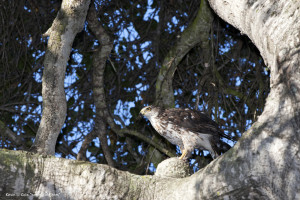
I contacted Allen Fish, director of the Golden Gate Raptor Observatory, for more information. He’s not taking a position one way or the other on the tree removal proposals, but he does provide some useful context regarding raptors: “Eucalyptus provide nesting sites for red-tailed hawks and great horned owls in particular (since the latter often nests in the platforms built by the hawks),” he said, “and red-shouldered hawks show up in eucs often, although their nests seem to get blown out of eucalyptus trees pretty easily.” So eucalyptus are good for those big, charismatic birds that are important predators.
But the story doesn’t end there: “Eucalyptus forests give redtails, redshoulders, and great horns an edge in these semi-rural zones (and ranchlands and parklands) that harbor lots of euc forests. But an edge over what? Over smaller, more ecologically specialized raptors, such as Cooper’s hawks, sharp-shinned hawks, American kestrel, western screech-owl, spotted and saw-whet owl—at least in the bay-oak-madrone and Douglas-fir forests. In grassland-savannah, redtails could edge out northern harriers, white-tailed kites, and even barn, short-eared, and long-eared owls.” Again, winners and losers either way.
“Part of the storyline here,” Fish continued, “is that the three euc-favored species (redtail, redshoulder, and great horns) are big, ecologically wide-ranging, human-tolerant raptors that are capable of preying on the smaller, crow- and robin-sized hawks and owls. And they do. Bottom-line: eucalyptus removal from the East Bay Hills – if those lands are restored with native broad-leaved forest and savannah—will likely increase diversity of raptors, maybe numbers as well.” But Fish would probably agree that the big “if” here is whether those lands will in fact be “restored with native broad-leaved forest and savannah.”
The amphibian experts

That caveat of how the work will be done is weighing heavily on the mind of David Wake, an expert on amphibians (and a main source for our January 2013 cover story on salamanders). “This issue has been a matter of considerable discussion in my neighborhood, Park Hills in Berkeley,” Wake wrote to me. “This is kind of like a small town, with about 500 people, and we border on Tilden Park. We are a prime target for any wildfire. Of course, we are adults and purchased our homes in the full knowledge of risks.”
“Personally I am ambivalent about the entire project,” he continued. “I would like to see some thinning of dense stands, but eucalyptus will root sprout for up to six years and the manpower necessary to do this mechanically without pesticides could be dauntingly expensive. I fear that we might end up making a mess of things. Also of concern is my fear that the people who will do this work are likely to be undereducated, young, and lightly supervised, so that care might not be uppermost in their minds.”
So then Wake is left with a quandary: “I know that one goal is to encourage the growth of understory native species such as bay laurel, live oak, and willow. However, my own observations would suggest that what is most likely to thrive will be an amalgam of introduced grasses, weedy forbs, introduced blackberry bramble and native poison oak. We could replace the current eucalyptus with a mess.” As to the herbicides, Wake has reviewed a number of papers over the years by Rick Relyea, at University of Pittsburgh, who has found some worrisome impacts from prolonged exposure to Roundup (here’s more about his work).
“Without doubt the substances are toxic to many organisms,” said Wake, “especially amphibians, and they are at least low-level carcinogens. Roundup and Garlon 4, two mentioned in the EIR, have been proven to have negative effects.”
I called Relyea to ask him how he’d weigh the merits of a project like this one. The short answer: Not easily. From his vantage in Pennsylvania, he’s not familiar with the particulars of this project, but he’s well aware of the debates and compromises that occur in large-scale restoration and invasive species management. The main issue with Roundup and related chemicals is not actually the herbicide itself (glyphosate, in the case of Roundup), it’s the “inerts,” which include surfactants. These work like extra-strength dish-soap to break down the waxy layers on leaves and allow the herbicide to penetrate into the plant.”It’s really hard to make something that’s good at killing weeds but that doesn’t kill frogs,” he said.
The East Bay hills EIS contains mitigation measures to avoid spraying herbicides near wetlands and stream courses, but there may still be impacts on amphibians. That said, Relyea was pleased to hear that even foliar applications of herbicides (those sprayed on leaves) will be done plant by plant and not through broadcast spraying. “If we’re talking about hand-applying to specific plants, it’s an order of magnitude lower application rate than fogging corn or soybeans,” he said. “You’re not having it drift over the landscape and into aquatic areas.”
“This is a really difficult risk assessment to make in my view. I would say that applying it to individual plants is a much better way, a much saner way to go about using the product. You’ve reduced the risk a great deal, in my opinion. Even those of who work at this all the time, it’s very difficult to say what the risk is, especially in light of the goal of the project, because having those nonnative trees there has an impact on habitat as well.”
“Every individual person has a different line or balance point where the benefits to society outweigh the cost to wildlife. We’ll never agree where that line should be.”
The ecologist and neighbor
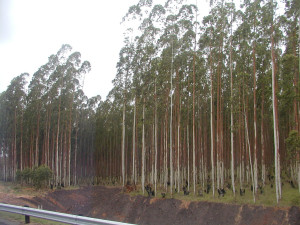
Understanding the interactions of people and habitat is the main work of Alan Shabel, an ecologist and a neighbor of David Wake’s.
Here’s what Shabel told his neighbors in one email: “I have now worked through the ~3250 pages in the Environmental Impact Statement (EIS), and I find it to be a very well researched set of documents. I studied forest succession as an undergraduate in the early 1990s, and I have been studying animal and plant ecology since that time. We should not miss this opportunity to better manage the local landscape and to become better ecosystem stewards.”
Shabel and I sat down to talk this week, and he told me about his own experience in eucalyptus forests here and in field work sites in Africa and South America. I was keen to hear his take on the situation because his main research concerns how humans and another hominid species coexisted in the African Rift Valley — with each other and a whole ecosystem — for a million years and more. Here’s a person with a long view of our role in the landscape, someone likely to have insight into the threads of this debate that center on whether and how native plants should or shouldn’t have priority in our management of local parklands (most forcefully argued at milliontrees.me).
“As simple poles: ‘only native’ and the opposite extreme, ‘no priority for natives,’ those are foolish ends of the spectrum,” he said. “What we have are changing systems with new elements that by most people’s accounts can’t be fully eradicated, nor would that be desirable.”
It turns out Shabel also has a more varied than average experience with eucalypts, having encountered plantations of them during fieldwork in Africa and South America.”I see eucalyptus through how they grow in Malawi, South Africa, Chile,” he told me. “When you move around the world and you see some of these particular species that are succeeding so well at the expense of locals, you can’t help but have concern for the diminishing locals everywhere. This isn’t xenophobia, this is a concern for the natives everywhere. Eucalyptus, whether it’s in Patagonia or Africa, completely dominates.”
But deciding how to deal with that dominance isn’t necessarily simple. “You’re talking about a dynamic ecosystem and working toward some goal, whatever it may be,” said Shabel. “Usually those goals relate to an assumption about a previous ecosystem condition. What was the ecosystem pre-eucalyptus? People speak with authority of what the system was at various times. Based on historical records and early photographs, there were very few trees. Why was that?”
Ecologists and botanists have pollen records and other evidence they can draw on for that, but nothing that will get down to specific canyons. “We don’t know what it was like 400 years ago, let alone 2,000 or 14,000. What was it before people got here? This was ground sloth county, this was camel country, not to mention the predators. There was a huge fauna that’s no longer here. Geologically that’s yesterday.”
And the hills as we know them will change again, either through the proposed aggressive management or through natural processes like fire. Shabel worries about potential drying out of treeless habitats and wonders if planting redwoods be a good idea in some areas where they don’t currently grow, but, for him, the managed succession embodied in the EIS seems like the best we can do with the evidence we have. “I prefer someone doing something, if aggressively, to doing nothing.”
Public Forum and Commenting
You can attend a public forum about the project this evening. The forum, sponsored by The Hills Conservation Network, is tonight, June 12 at 7:30 pm at The Hillside Club, 2286 Cedar Street (at Arch). You can comment on the FEMA proposal until Monday, June 17. Here are instructions on how to comment.
You can also read an extensive Q & A with Tom Klatt, UC’s project manager for the tree removal work, over at Berkeleyside.

